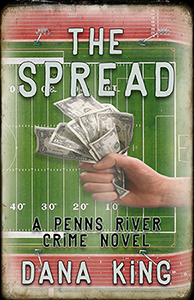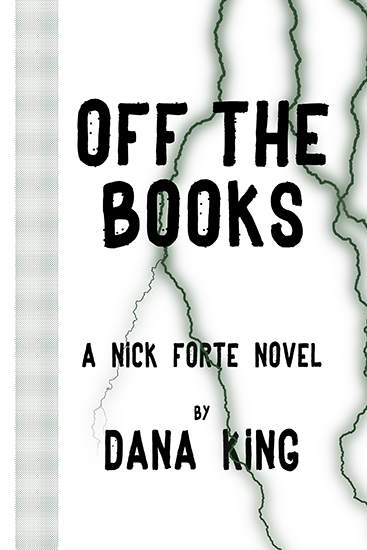While I was, of course, acquainted
with the name, I first met J. L. Abramo at the Shamus banquet in New Orleans a
couple of years ago when we both sat at the Down & Out Books table, where
we were both nominated for the same award; he won. While I am in full agreement
with those who say there is no nicer or more welcoming group of people than
crime fiction writers, even in that group there is a small cadre who stick out
as true gentlemen in the traditional sense of the word. Joe is one of them. It’s
always a treat when he stops by the blog because I know he’ll give thoughtful,
well-reasoned, and honest answers to anything I ask.
One Bite at a Time: Your new book is titled American
History. It’s the story of a feud between two Sicilian families that is
carried to the United States prior to the First World War and ultimately spans
the American continent. Give us a little taste of what to expect.
J.L. Abramo: The families of Salvatore Leone and Luigi Agnello had
already been long-time bitter enemies in Sicily by the turn of the twentieth
century.
In 1913, Vincenzo Leone,
Salvatore’s oldest son, emigrates to Philadelphia to start a new life for
himself and his family in the promised
land. Several years later, Giuseppe Agnello, Luigi’s eldest, secretly
marries Francesca Leone, Vincenzo’s sister, and the couple escape to New York
City. Giuseppe leaves to serve his new country during the First World War. Francesca, alone and in need of support for
herself and their infant son, Louis, travels to Philadelphia to live with her
brother, his wife, and his two daughters. The Spanish Flu takes the lives of
Vincenzo’s wife and sister in 1918, and Leone moves with his daughters and
Francesca’s son to San Francisco. Vincenzo decides to raise his nephew, Louis
Agnello, as his own child.
When Giuseppe returns from the
war, he finds his wife and son gone. It takes more than five years for Agnello
to learn the whereabouts of his family. Giuseppe travels to San Francisco with
hopes of a reunion with Francesca and Louis, and becomes a victim of the animosity
between the two families—hatred recently transplanted in
America by Vincenzo Leone’s younger brother, Roberto.
American History is the epic, generational saga of the Agnellos and
the Leones (in the Italian language, lambs
and lions)—a one-hundred-year
conflict between Giuseppe’s descendants in New York, law enforcers, and
Vincenzo’s descendants in San Francisco, lawbreakers.
OBAAT: You’re best known for your Jake Diamond PI series—Circling
the Runway won the Shamus Award in 2016 for Best Paperback Original.
(I’ll always remember that because you beat me. Not that I’m bitter.) You built
a solid reputation on the Diamond books and contemporary Brooklyn-based police
procedurals Coney
Island Avenue and Gravesend.
American History is a much different
book, with a far broader scope. What drew you to the idea?
JLA: I am a first generation
American. My mother and her family
emigrated to New York from Stalinist Russia in the 1920s.
My paternal grandfather,
Giuseppe, emigrated from Naro, Sicily in 1909.
He left behind a pregnant wife and two children. After five years of manual labor, he had
earned enough to send for his family. My
father turned five years old on his ocean journey to America in 1914, and upon
arrival in New York met his father
for the first time.
Gravesend and Coney Island
Avenue were personal journeys back to my
native land, Brooklyn. American History was, in the writing, a
trip further back in my heritage—an
exploration of the immigrant experience.
I have always considered the courage of those who came to America in the
late 18th and early 19th centuries—facing
alien customs, a foreign language and, in many cases, ethnic prejudice and
persecution—to be
remarkable. I recognized that adapting to these new circumstances took different
paths, some outside the law, although the motivations were the same—to insure the safety and
honor of the family. With those thoughts in mind, the idea for a generational
family saga took hold.
OBAAT: How long does it take you to write, say, a Jake Diamond
novel, and how long did it take to write American
History?
JLA: That is a question with
no clear answer. There are many
mitigating circumstances.
I wrote Catching
Water in a Net in less than a month, to satisfy a submission
deadline. The book miraculously captured
the St. Martin’s Press/Private Eye Writers of America prize for Best First
Private Eye Novel. Working with my editor to clean up a very convoluted plot
took longer than writing the book did originally.
Gravesend, from inception through many transformations and ultimate
publication, was a twelve-year process.
Brooklyn
Justice came out of the gate full-speed and quickly raced to the finish
line.
American History was started and then set aside for some time
before it dawned on me what the novel was meant to be about.
OBAAT: American History
takes place over a period of a hundred years across a significant geographic
expanse. What kinds of research did you do?
JLA: Research is always an
important element of my work, particularly with respect to setting. I consider the location of a story, cities in
particular, to be a critical component—and
I work diligently to get even the basics like street intersections correct.
Time period also requires
accuracy and adequate research. Chasing Charlie Chan is set in 1994—which was nearly twenty
years before I wrote the book—and
also deals with events from the 40s. A
great deal of research was necessary
and, at the same time, enjoyable.
American History, because of the period of time it covers, was even
more demanding. It was important to me
to follow the generations of these two families within the context of some of
the major events in America during those ninety years. I wanted the history of the Agnellos and the
Leones to be worthy of the designation American
history.
OBAAT: Looking back through your two previous visits here to OBAAT,
I see what became American History
had at least bits of your attention while you worked on multiple other projects.
You also mentioned you start with a situation and go where it takes you. Was it
hard to hold that together through periods of working on something else?
JLA: This book also began
with a situation, a visualized scene, almost cinematic, involving a man being
released from prison with the strong sense that he may have been safer inside
than out. The question then became why. It
took a while (during which I worked on other projects) before I saw his
situation as a result of a conflict that went back to his great-grandparents a
century earlier—and decided
the novel would, in the end, concern family honor and survival and the
assimilation to new environments and changing times.
OBAAT: Who are your primary influences on your writing? Not
necessarily writers. Could be filmmakers or musicians. Have those influencers
changed over time?
JLA: Although I am considered
a crime novelist, my work is most
often concerned with how people deal with adversity—positively or negatively. And family—its importance, and the
constant incentive for family respectability and loyalty, are also common
themes in my novels. These themes are inspired by personal experiences and
everything I see and hear about such concerns and store away to be tapped
later, consciously or otherwise. I often create characters who are as
courageous and as loyal as I would hope to be.
An artistic work which illuminate these sorts of themes—be a John Irving novel, a
Sidney Lumet film, or a Bruce Springsteen song—influence
me in that direction.
OBAAT: Writers are great readers. What do you look for in a book
that makes it rise above the rest? On the flip side, is there anything that
will cause you to put a book down? I’m asking not so much about the absence of
what you like, but the presence of something you actively dislike.
JLA: Of late, I have been
reading more non-fiction. At this stage
of my life, I feel it is a better use of my time to examine the events of the
near and distant past because it helps me better understand how we’ve arrived
where we are and inspires me to write more informed and hopefully more relevant
work.
For example, I have very recently
read The Fifties by David Halberstam. It was enlightening and has provided me with
a great deal of solid information which is assisting me in writing about a
series of events which occurred during that period. I am presently reading In the Garden of Beasts by Erik Larson. Its depiction of Berlin in 1933, all of the clear
warnings ignored, illuminates those dangerously ignored today.
In regard to the flip side there is a lot out there that I
find derivative, gratuitously dark—as
evidenced, for example, by the recent preponderance of noir by writers who, in
many cases, seem to pay more attention to the level of depravity than to an adherence
to the strict qualifications of the sub-genre.
It has almost become a fad. It feels too much like noir for noir’s sake. I have participated in several Noir at the Bar events where very little
that was read, including my own work, was what I would consider noir fiction. When James M. Cain wrote The Postman Always Rings Twice, considered
a definitive example of the genre, I don’t believe he set out with the goal of
writing noir. Rather—when as a journalist
covering the Snyder-Gray murder trial in 1927, where Ruth Snyder and her lover
Henry Gray were accused of killing Snyder’s husband for the insurance money—I suggest
he simply came up with a good idea from people who had a bad idea.
If I get the impression that an
artistic endeavor is motivated by what is the flavor of the day—rather than by the need
to set free authentic feelings and desires—I
tend to pass.
There is so much excellent
writing out there, particularly in television, it is humbling. The only way I
can personally justify my efforts is if the work is a journey that is
surprising and revealing to me
and—subsequently,
perhaps—for a fellow
traveler, a.k.a. the
reader.
OBAAT: The inevitable final question: What are you working on now?
JLA: I have just completed a
new Jake Diamond novel which, if meant to be, could hit the streets in 2019.
Ironically, I have been invited
to contribute a short story for a noir
anthology and I have a decision to make. Pass, with
the justification that it’s just not my
thing—or give it a shot as an intellectual exercise. Que
sera, sera.
I am
working on a few other projects, both quite different from any of my previous
efforts. Once I figure out what they are
supposed to be, I will be able to tell you more.




